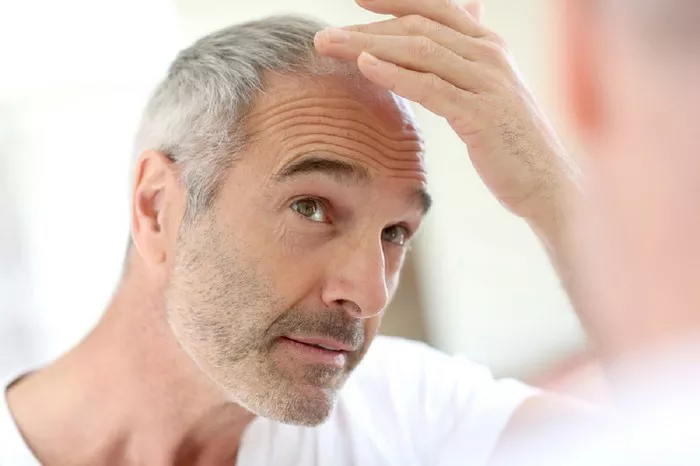Androgenic alopecia (AGA), commonly known as male or female pattern baldness, is the most prevalent cause of hair loss in both men and women. Characterized by a progressive thinning of the hair, AGA typically follows a predictable pattern, with hair loss occurring primarily at the temples and crown in men, and diffuse thinning along the central scalp in women. While the exact etiology of AGA is multifactorial and complex, it primarily involves genetic predisposition and hormonal factors, particularly changes in androgen metabolism.
AGA is intricately linked to the effects of androgens, namely dihydrotestosterone (DHT), on hair follicles. In individuals genetically predisposed to AGA, hair follicles become increasingly sensitive to DHT, a potent androgen derived from testosterone through the action of the enzyme 5-alpha reductase. This heightened sensitivity leads to a process known as miniaturization, wherein hair follicles progressively decrease in size and diameter with each hair growth cycle. Over time, miniaturized hair follicles produce finer, shorter hairs until they eventually cease to produce visible hair altogether, resulting in baldness.
Available Treatment Options
While AGA poses significant challenges in terms of treatment, several options are available to manage and potentially reverse hair loss. Among these, minoxidil and finasteride stand out as the most widely recognized and extensively studied treatments.
Minoxidil:
Topical minoxidil, available over-the-counter in various formulations, represents a cornerstone of AGA therapy. Originally developed as an oral antihypertensive medication, minoxidil’s serendipitous side effect of hair growth led to its formulation as a topical solution for AGA. Minoxidil is thought to exert its hair growth-promoting effects by widening blood vessels, thereby enhancing oxygen, blood, and nutrient supply to hair follicles. While the exact mechanism of action remains incompletely understood, clinical studies have consistently demonstrated its efficacy in slowing hair loss and promoting hair regrowth in both men and women with AGA.
Finasteride:
Oral finasteride, a 5-alpha reductase inhibitor, represents another mainstay of AGA treatment. By selectively inhibiting the type II isoform of 5-alpha reductase, finasteride reduces the conversion of testosterone to DHT, thereby mitigating the hormonal component of AGA. Clinical trials have shown finasteride to be effective in halting hair loss and promoting hair regrowth, particularly in men with mild to moderate AGA. However, its use in women of childbearing age is limited due to potential teratogenicity and the risk of feminization in male fetuses.
Other Novel Therapies
In addition to minoxidil and finasteride, several emerging therapies show promise in the management of AGA.
1. Low-Level Laser Therapy (LLLT):
LLLT, also known as red light therapy or photobiomodulation, has gained attention as a non-invasive treatment option for AGA. By stimulating cellular activity within hair follicles, LLLT is hypothesized to promote hair growth and improve hair density. Although the precise mechanisms of action are not fully elucidated, clinical studies have demonstrated favorable outcomes with LLLT in both men and women with AGA, with minimal side effects reported.
2. Microneedling:
Microneedling, or dermarolling, involves the use of a device equipped with fine needles to create micro-injuries in the scalp. These micro-injuries stimulate the release of growth factors and cytokines, promoting tissue repair and neovascularization. Studies investigating the efficacy of microneedling for AGA have shown promising results, with improvements in hair density and thickness observed following treatment.
3. Platelet-Rich Plasma (PRP):
PRP therapy involves the collection and concentration of platelets from the patient’s own blood, which are then injected into the scalp. Platelets contain various growth factors and cytokines that stimulate hair follicle activity and promote hair growth. While clinical evidence supporting the efficacy of PRP for AGA is mixed, some studies have reported significant improvements in hair density and thickness following PRP treatment.
Combination Therapies
Recognizing the multifactorial nature of AGA, some clinicians advocate for combination therapies to optimize treatment outcomes.
Quality of Evidence
Despite the array of treatment options available for AGA, the quality of evidence supporting their efficacy varies widely.
Benefits and Risks
When considering treatment options for AGA, it is essential to weigh the potential benefits against the associated risks and limitations. Additionally, individual patient factors, including age, gender, comorbidities, and aesthetic goals, should be taken into account when formulating a treatment plan.
In conclusion, AGA represents a complex and challenging condition with significant psychological and emotional implications for affected individuals. While several treatment options exist, including minoxidil, finasteride, and emerging therapies such as LLLT, microneedling, and PRP, further research is needed to elucidate their mechanisms of action and optimize treatment outcomes. By considering the available evidence and individual patient characteristics, healthcare providers can tailor treatment approaches to effectively manage AGA and improve the quality of life for those affected by this common condition.


